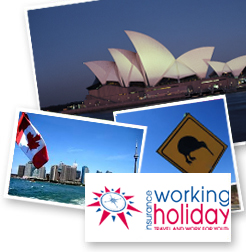·
- As the economic crisis continues to affect countries across the world, the option to work abroad is becoming increasingly popular amongst young people
- Education, work and sports are the most sought after activities by temporary foreign workers
 As a result of the economic crisis, one of the words that we have incorporated into our language is ‘emigration’. Tens of thousands of young people have already crossed the border in search of a better future, from neighboring countries to even as far as the Asian market.
As a result of the economic crisis, one of the words that we have incorporated into our language is ‘emigration’. Tens of thousands of young people have already crossed the border in search of a better future, from neighboring countries to even as far as the Asian market.
In this case, one of things that is influencing those deciding to work abroad more and more is the Work and Travel Program (PVT in Spanish or French) or the Working Holiday Visa, which allows those under 35 to work and holiday at the same time in a foreign country for between 6 and 12 months.
Also called the Holiday-Work Visa (VVT in Spanish) or the Working Holiday Program, it is the result of mutual agreements that seek to encourage young people to travel to all parts of the world, with the possibility of finding part time work to finance their stay there. Australia, Canada and New Zealand are considered the best destinations by those embarking on such an adventure.
Working while on holiday or during the summer
There are two categories within the Holiday and Work Program. The first of these provides the opportunity for students to work during the summer months. This is designed for younger students who want to take advantage of their summer break and experience working abroad, with a maximum period of 3 months. For this option it is essential that the student is enrolled in post-secondary education or at a training centre and carries the requested travel insurance.
 The other option concerns working while holidaying, designed for travellers who want to sightsee, get to the know the culture and work at the same time. The maximum duration is 12 months. This is the option that is becoming increasingly more popular amongst Spaniards, as it offers a clear solution to the problem of unemployment that is affecting many countries, with the added attraction of possibly learning a new language.
The other option concerns working while holidaying, designed for travellers who want to sightsee, get to the know the culture and work at the same time. The maximum duration is 12 months. This is the option that is becoming increasingly more popular amongst Spaniards, as it offers a clear solution to the problem of unemployment that is affecting many countries, with the added attraction of possibly learning a new language.
Beatriz Valiente, in charge of customers relations at AVI International, highlights “the significant increase in the number of calls and contact we have received regarding our Working Holiday insurance for 2012, especially insurance for general covers”. Other issues of particular interest for applicants are that this visa has “the option of integrating sports and leisure or manual work into the insurance, and that it includes the possibility to visit neighbouring countries, which it does include, but only for a maximum of two weeks.”
And what destinations do people choose? There are dozens of countries that you can travel to with a Working Holiday visa. China and Taiwan are recent additions, although they are not yet in high demand. “100% of those Spanish people insured have chosen Canada to carry out their Working Holiday”, Beatriz Valiente points out, “while the majority of French insured go to Australia, followed by New Zealand and then Canada. Very few opt to travel and work in other countries such as such as Argentina, South Korea, Japan or Singapore and the new destination: Hong Kong.”
5 pieces of advice for the Working Holiday Visa
When it comes to applying for a Working Holiday visa, often there are limitations attached to the criteria that the applicant must meet, which in many cases are restrictive:
- It is essential to be between 18 and 35 years old, with both these ages included.
- For some destinations it is necessary to carry with you a large sum of money as costs can escalate at the beginning of your stay.
- One of the key requirements is that your medical insurance covers you for the entire duration of your stay. When it comes to confirming it, Beatriz Valiente adds that this criterion is “absolutely essential for the Working Holiday visa to be accepted.”
- It is important to know what limitations exist when it comes to studying and working. In the case of New Zealand and Canada, the Working Holiday visa only allows you to study for a period of 6 months, and to work for up to 1 year. As for Australia, a certain level of accredited English is also required. Your country of origin can also play a part in what countries you can travel to.
- Analysing the possible destinations and their economic and unemployment rates, with the aim of choosing a country that offers the best employment opportunities.
Therefore it is important to know in detail the necessary requirements and characteristics for each country, so that you can plan in advance on how to make the most of your trip and have the best experience possible. Looking ahead, it is one of the options being considered more and more: “I believe that it is a product that will work really well in the next few years; many Spaniards leaving the country in search of work, prices are economical and conditions are very good”, concludes our contact at AVI International.
___________________________
Today’s post is from AVI International, a leading provider of travel insurance for tourists and those who holiday abroad.

nice……